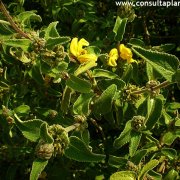Care of the shrub Phlomis cypria or Cyprus sage |
|
The genus Phlomis, family Lamiaceae, comprises 100 species of shrubs and herbaceous plants native to Asia and the Mediterranean region. Some species are: Phlomis cypria, Phlomis chrysophylla, Phlomis purpurea, Phlomis fruticosa, Phlomis italica, Phlomis russeliana, Phlomis lycia, Phlomis samia, Phlomis lanata, Phlomis lychnitis, Phlomis maroccana, Phlomis viscosa. Common name: Cyprus sage. This species is native to the island of Cyprus, eastern Mediterranean. They are hairy evergreen shrubs that reach 1.20 meters (3.93 feet) in height. They have opposite, whole leaves, velvety in texture and grayish-green in color. The attractive deep yellow flowers appear in whorls surrounding the stems. They bloom during the summer. Cyprus sage is used to form bushy groups with other Mediterranean plants, as isolated specimens, to cover stony slopes for low maintenance and in pots for terraces and patios. Phlomis cypria can be grown in direct sunlight or semi-shade exposures. It resists occasional frosts. The soil can be a mixture of garden substrate with coarse sand and a little organic matter; it also grows on poor and stony soils. Phlomis cypria has good resistance to drought. Water moderately, always waiting for the substrate to dry. Cyprus sage does not need fertilizers. Prune dry flower stems and vigorously prune old specimens in late winter to strengthen them. Phlomis cypria is a resistant plant to the usual pests and diseases. Cyprus sage is propagated by cuttings and from seeds sown in spring. |
Images of the shrub Phlomis cypria or Cyprus sage |
Find plants
Phlomis cypria or Cyprus sage | Care and Growing
© 2025 FavThemes



